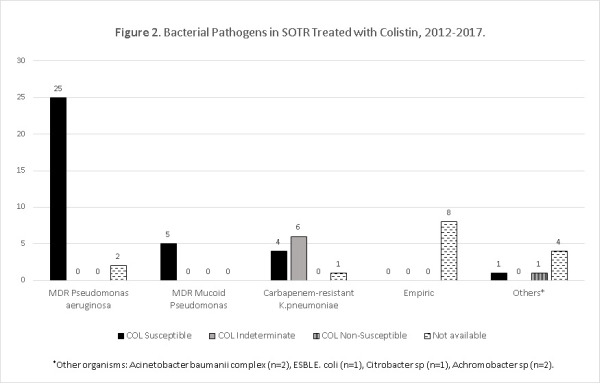Colistin (COL) in Solid Organ Transplant Recipients (SOTR): Friend or Foe?
Cleveland Clinic, Cleveland, OH.
Meeting: 2018 American Transplant Congress
Abstract number: C330
Keywords: Bacterial infection, Infection, Lung infection, Lung transplantation
Session Information
Session Name: Poster Session C: Transplant Infectious Diseases
Session Type: Poster Session
Date: Monday, June 4, 2018
Session Time: 6:00pm-7:00pm
 Presentation Time: 6:00pm-7:00pm
Presentation Time: 6:00pm-7:00pm
Location: Hall 4EF
Background: Data on COL use in SOTR are lacking. In other populations, high dose (HD) COL (>4.4mg/kg/day) has been associated with clinical and microbiologic cure and decreased mortality.
Objectives: To describe the use, efficacy and safety of COL in multidrug-resistant gram-negative bacterial infections (MDR-GNI) in SOTR.
Methods: Retrospective study of adult SOTR with MDR-GNI who received COL≥48h, 2012-2017. We collected data on demographics, infection, COL dose and adverse effects. Primary outcome was clinical cure defined as resolution of signs and symptoms. Secondary outcomes were 30 and 90-day mortality, development of nephrotoxicity in SOTR with normal baseline creatinine and microbiologic cure defined as clearance of cultures at index site within 7 days.
Results: 68 SOTR received COL; 14 were excluded (12 for COL<48h, 2 for colonization without infection), leaving 54 for analysis. Mean age was 49.6(±15.3) years. 56% were male (n=30). 93% received antibiotics 30 days prior (n=50).
Mean COL dose was 4.45(±0.64) mg/kg/day. Median duration of COL was 7 (Q1=3.25; Q3=15) days. Clinical and microbiologic cure was attained in 55.6% (n=30) and 55.1% (n=27), respectively. The incidence of nephrotoxicity among was 17.2% (n=5). Overall 30 and 90-day mortality rates were 38.9% and 55.6%, respectively. HD COL was not associated with clinical (p=0.81), microbiologic cure (p=0.46), 30 (p=0.53) or 90-day (p=0.40) mortality. HD COL was not associated with nephrotoxicity (p=0.69). No other adverse effects were seen.
Conclusions: COL treatment achieved moderate success in clinical and microbiologic cure with relatively low rate of nephrotoxicity. Mortality in setting of MDR-GNI remains high. Outcomes were not associated to HD COL but study was limited due to sample size. Larger studies comparing COL to newer, better tolerated regimens are needed.
CITATION INFORMATION: Neyra K., Huauya Leuyacc C., Kovacs C., Athans V., Cober E. Colistin (COL) in Solid Organ Transplant Recipients (SOTR): Friend or Foe? Am J Transplant. 2017;17 (suppl 3).
To cite this abstract in AMA style:
Neyra K, Leuyacc CHuauya, Kovacs C, Athans V, Cober E. Colistin (COL) in Solid Organ Transplant Recipients (SOTR): Friend or Foe? [abstract]. https://atcmeetingabstracts.com/abstract/colistin-col-in-solid-organ-transplant-recipients-sotr-friend-or-foe/. Accessed December 26, 2025.« Back to 2018 American Transplant Congress


